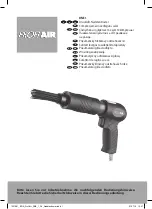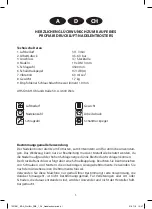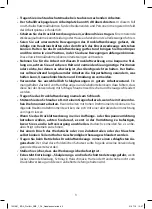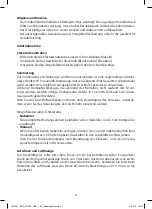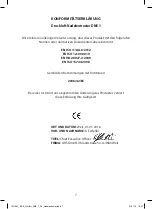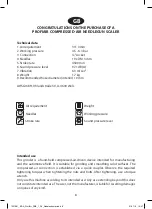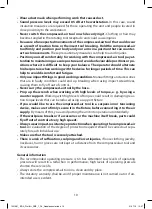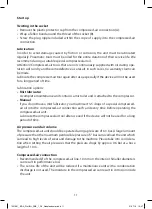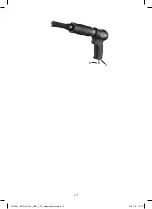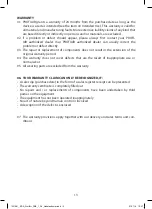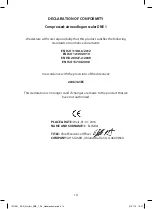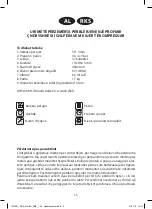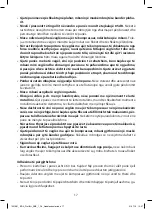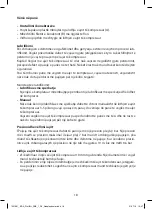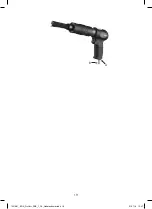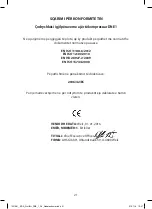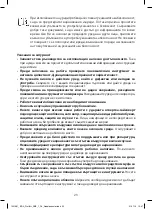
10
• Wear a dust mask when performing work that causes dust.
• Sound pressure levels may exceed 85 dB at the workstation. In this case, sound
insulation measures are required for those operating the unit and people located in
close proximity to the workstation.
• Never switch the compressed-air tool on while carrying it. Clothing or hair may
become tangled in the rotating tool receptacle and could cause injuries.
• Be aware of unexpected movements of the compressed-air tool that could occur
as a result of reaction force or the insert tool breaking. Hold the compressed-air
tool firmly and position your body and your arms in a position that can counter-
act such movements. These precautionary measures can help to avoid injuries.
• Position yourself comfortably for working with the compressed-air tool; pay at-
tention to maintaining a secure posture and avoid unfavourable positions or po-
sitions where it is difficult to keep your balance. The operator should alternate
his/her posture when working with the device for longer periods of time. This can
help to avoid discomfort and fatigue.
• Only use impact fittings in good working condition. Manual fittings and accessories
that are in faulty condition could end up breaking when using impact screwdrives,
causing them to fly off out of control..
• Never carry the compressed-air tool by the hose.
• Prop up the wrench when working with high levels of torque, e. g. by using a
counter support. Working with high levels of torque could result in damaging reac-
tion torque levels that can be reduced using a support fixture
• If you would like to use the compressed-air tool in a suspension or tensioning
device, make sure to firmly secure it in the fixture before connecting it to the air
supply. By means of this, you avoid putting the unit into operation unintendedly.
• If the workpiece breaks or if accessories or the machine itself break, parts could
fly off out of control at very high speeds.
• Always wear impact-resistant eye protection when operating the compressed-air
tool. An evaluation of the degree of protection required should be carried out sepa-
rately for each individual use.
• Make sure that the tool is securely attached.
• There is a risk of suffocation, scalping and/or cut injuries, if loose clothing, jewelry,
necklaces, hair or gloves are not kept at a distance from the compressed-air tool and
its accessories.
General information
• The recommended operating pressure is 6.3 bar. Attention! Low levels of operating
pressure will result in a reduction in performance; high levels of operating pressure
shorten the service life.
• Always store the compressed-air tool in a clean and dry place.
• The statutory warranty shall be void if proper maintenance is not carried out or if un-
intended use is evident.
1231681_ BDA_ProfiAir_DNE_1_DL_Nadelentroster.indd 10
21.07.16 12:47
Summary of Contents for ProfiAir DNE 1
Page 13: ...12 A B 1231681_ BDA_ProfiAir_DNE_1_DL_Nadelentroster indd 12 21 07 16 12 47 ...
Page 20: ...19 A B 1231681_ BDA_ProfiAir_DNE_1_DL_Nadelentroster indd 19 21 07 16 12 47 ...
Page 41: ...40 A B 1231681_ BDA_ProfiAir_DNE_1_DL_Nadelentroster indd 40 21 07 16 12 47 ...
Page 54: ...53 A B 1231681_ BDA_ProfiAir_DNE_1_DL_Nadelentroster indd 53 21 07 16 12 47 ...
Page 61: ...60 A B 1231681_ BDA_ProfiAir_DNE_1_DL_Nadelentroster indd 60 21 07 16 12 47 ...
Page 68: ...67 A B 1231681_ BDA_ProfiAir_DNE_1_DL_Nadelentroster indd 67 21 07 16 12 47 ...
Page 75: ...74 A B 1231681_ BDA_ProfiAir_DNE_1_DL_Nadelentroster indd 74 21 07 16 12 48 ...
Page 82: ...81 A B 1231681_ BDA_ProfiAir_DNE_1_DL_Nadelentroster indd 81 21 07 16 12 48 ...

